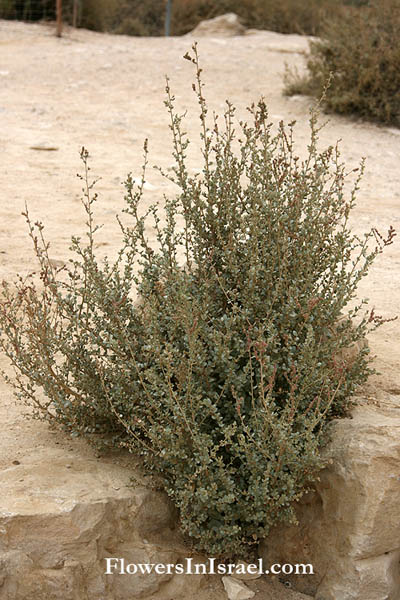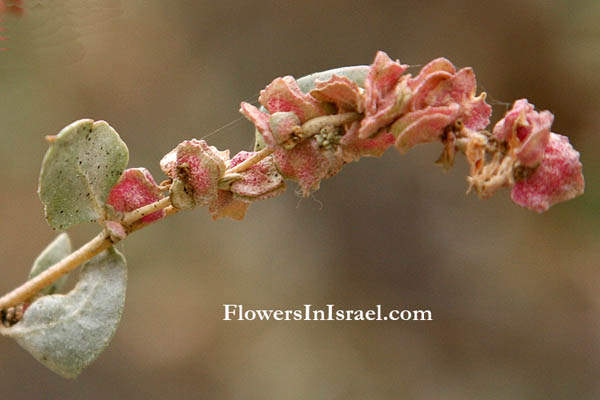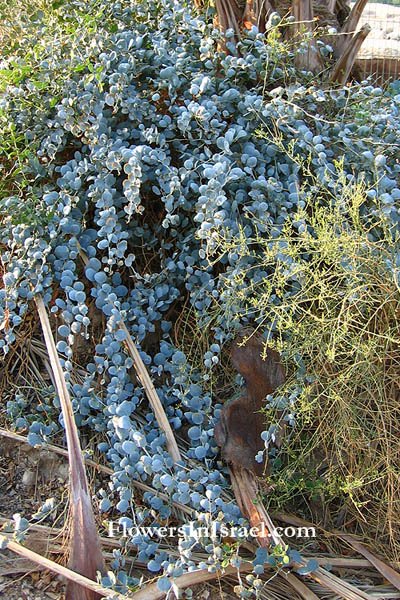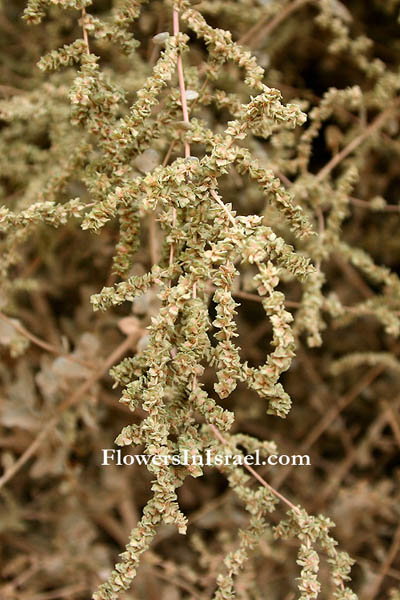Shrubby Saltbush, Hebrew: מלוח קיפח, Arabic: قطف، رغل،
| Scientific name: | Atriplex halimus L. | |
| Common name: | Sea Purslane, Shrubby Orache, Shrubby Saltbush | |
| Dutch name: | Melde | |
| Hebrew name: | מלוח קיפח | |
| Arabic name: | قطف، رغل، | |
| Family: | Chenopodiaceae, סלקיים |

|
| Life form: | Phanerophyte, shrub | |
| Succulence: | bladderlike hairs - salt bladders - salt hairs - vesicular hairs | |
| Stems: | Mealy shrub, creeping rootstock, 100-200 cm tall; branches from the base, both stems and leaves are covered with several layers of vesicular hairs | |
| Leaves: | Alternate, entire, covered with several layers of vesicular hairs | |
| Flowers: | Green | |
| Fruits / pods: | Minute nutlets enclosed in 2 leathery scales | |
| Flowering Period: | April, May, June, July, August, September, October | |
| Habitat: | Salty habitats | |
| Distribution: | Mediterranean Woodlands and Shrublands, Semi-steppe shrublands, Shrub-steppes, Deserts and extreme deserts | |
| Chorotype: | Med - Saharo-Arabian | |
| Summer shedding: | Perennating |

Derivation of the botanical name: Atriplex, ατραφαξιϛ, ατραφαξυϛ, αδραφαξυϛ, ανδραφαξιϛ, a pot-herb like spinach, orach (Atriplex hortensis) from which the entire genus gets its name. halimus, αλιμοϛ, of or belonging to the sea. In Hebrew, in Chaldee, and in Syriac, the word Maluach, מלוח, implies a brackish or salt-tasted plant. In the Septuagint, it is rendered ,άλιμα, the halimus. The Hebrew word: מלוח, Maluach, comes from melech, מלך, salt, The translation of the Hebrew word 'maluach', מלוח (from melech, מלך, salt), is 'orache' and not 'mallow'.
Fresh leaves and succulent stems of Atriplex halimus can be a crucial source of perennial fodder to camels (Camelus dromedarius). A study brought to light that Atriplex halimus diet (supplemented with barley) could meet the nutritional needs for growth and milk production in camels. The fat sand rat (Psammomys obesus; Gerbillinae), a diurnal gerbillid rodent, is herbivorous and able to thrive while consuming only the saltbush Atriplex halimus, a plant relatively low in energy content and high in ash and water. Atriplex halimus provides a stable diet throughout the year and fat sand rats have no competition for this food resource from other rodents. It has a high-electrolyte content. The fat sand rats scrape the outer layer of Atriplex halimus leaves with their teeth before consuming them, thus removing much of the electrolytes. Consumption of Atriplex halimus fulfills the energy and water needs of the fat sand rat / Psammomys obesus. The rodents thrive on this plant primarily by the behavioral ability to remove electrolytes before consuming its leaves and by their ability to consume large quantities of it. See the list of Medicinal herbs in Israel, the parts used and their medical uses to treat various diseases. 1) because the Syrians still call this plant by the same name; 2) because the Hebrew name and the Greek άλιμος refer to the salt taste which the Arab writers attribute to this plant ; 3) because as the maluach is described as the food of the wretched, so is the halimus in Athenaeus; 4) because the LXX render מלוח by 'AΛIMA ; and (lastly) because it is described in Job as cropped upon the shrub, which exactly agrees with what the Arab writers say of the maluch or hulimus, namely, that they ate the tops of it. Bible resources:


|